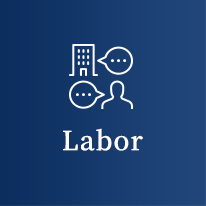What to do when a labor tribunal complaint is filed
What is a labor tribunal?
The labor tribunal procedure is a dispute resolution procedure specializing in labor cases that began in April 2006. Compared to court proceedings, labor-management disputes are resolved more quickly. Since the cases covered by the procedure are limited to those related to labor, most cases are either claims for payment of unpaid overtime or requests for confirmation of the invalidity of dismissal. The Labor Tribunal Committee consists of three members: a labor tribunal judge, a labor tribunal member representing the workers, and a labor tribunal member representing the company. The hearing procedure takes place in the courtroom, but in a conference room-like setting that is different from a regular courtroom.
Procedurally, the hearing is similar to a conciliation, with the labor tribunal hearing the arguments of both parties, presenting a reasonable solution, and proceeding in the direction of gaining the consent of the parties. If a party objects to the labor tribunal, he or she may file an objection, and the case will be transferred to an ordinary lawsuit.
Rapid Dispute Resolution Procedure
The labor tribunal is characterized by its ability to quickly resolve disputes. The company is required to submit its written answer and evidence by about one week before the first date. Therefore, the time for preparation is limited to about 30 days at the most. Since the actual time is extremely limited, the company’s attorney must quickly get an overview of the case, conduct hearings with relevant parties, examine the evidence, and prepare statements from the parties involved in the case. The outcome of the case will be greatly affected by how persuasive your arguments and explanations are on the first date. It is important to grasp the overall picture of the case, and to be able to present a solid story while fleshing it out with evidence.
First Date
On the first date, the hearing examiners often ask various questions to the representatives of both sides, and unlike in a regular lawsuit, the representatives are expected to answer as much as possible on the spot. In this regard, it is preferable to have a representative of the company or a person in charge of the case who is familiar with the details of the case present at the first date. At the first meeting, both sides will be instructed on what additional materials and evidence to submit. The direction of most of the settlement proposals may also be given. As an attorney, it is necessary to understand the details of the case in advance and be prepared to answer questions from the labor tribunal (judge) in an appropriate manner. Most of the questions asked by the referee (judge) are related to the facts, so it is important to be able to understand and remember the facts in advance.
Second Date
On the second date, the trial examiners will review the additional evidence submitted and present a settlement proposal to both parties (agents). Although the trial examiners will ask the parties to consider the proposal carefully, in reality, the trial examiners will almost force the parties to make a decision whether or not to agree to the proposed settlement. However, in most cases, a one-sided settlement proposal based solely on the opinion of one party is rarely presented, and it is more likely that a settlement proposal that takes into consideration the positions of both parties will be presented. For example, in cases of invalidation of dismissal, the dismissal may not be invalidated, but the company may be asked to pay the employee a settlement amount equivalent to three months to one year’s salary. In our experience, the amount of the settlement is often equivalent to 3 to 6 months of salary, and if the settlement is offered closer to 12 months, we believe that the settlement offer is quite favorable to the complainant. Considering the litigation that will follow, the company would prefer to accept the settlement if the settlement amount is equivalent to March through June salary.
Third Date
The third date is simply to confirm that both parties agree to the settlement proposed by the labor tribunal procedure. In fact, nearly 80% of all cases are resolved by settlement.
The introduction of the labor tribunal procedure has enabled the prompt resolution of disputes, and it has been extremely well received by all concerned, including lawyers. However, nationwide, more courts have not yet introduced labor tribunal procedures, and it is expected that labor tribunal procedures will be established in the regions in the future, while also considering private law budgets.
Judgment
If a settlement is not reached within three labor tribunal dates, the case will be referred to a labor tribunal (decision). If there is no dissatisfaction from either party, the content of the appeal becomes final, and the parties will pay money, etc., in accordance with the content of the appeal. If any party is dissatisfied with the decision, it will file an objection to the labor tribunal, and the case will be transferred to an ordinary lawsuit. Among the cases we have handled, only one case was transferred to an ordinary lawsuit due to an objection filed by a party. However, considering the cost of the lawsuit (including attorney’s fees), we have our doubts as to whether the transfer to litigation was appropriate. If the parties have strong feelings about the case, they will have no choice but to settle the case by litigation.
Attorney’s Fees in Labor Tribunal Proceedings
While a labor tribunal case is completed in about 70 days from the filing of a petition, a lawsuit takes from one to one and a half years or more, during which much time is spent on the submission of evidence, verification, rebuttal, and so on.
From the standpoint of an attorney, the time and burden required to prepare for labor tribunal procedures are often three to five times greater than those required for labor tribunal proceedings. In terms of attorney’s fees, labor tribunal cases often cost from 800,000 to 1,000,000 yen (including the start-up fee and contingency fee), while labor-related lawsuits require from 1,000,000 to 3,000,000 yen (including the start-up fee and contingency fee). From this point of view, labor tribunal is less expensive and is considered to be a good choice for handling labor cases.
Use of Lawyers in Labor Tribunal
In a labor tribunal, evidence must be examined within a very limited time frame, the direction of the claim must be determined, and a written defense must be prepared. It is extremely difficult for the company’s staff to handle the case alone, so the support of an attorney is inevitably important. It is important for the person in charge of the company to consult with a law firm as soon as possible after receiving the labor tribunal petition. The later a law firm takes charge of the case, the less time it has to prepare, and the more restrictions are placed on its preparation. Kuribayashi Sogo Law Office has experience in handling many labor tribunal cases and labor lawsuits in cases involving invalidation of dismissals and claims for payment of unpaid overtime wages, so please contact us if you need representation regarding labor tribunal cases.










